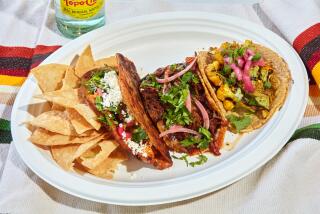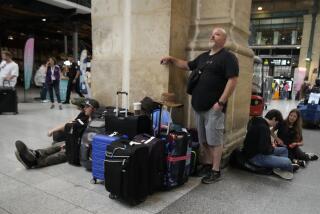Picnic a Delight Taken Aboard Europe’s Railways
- Share via
It’s a mystery--Americans’ infatuation with rental cars for touring Europe. Trains have always been and will continue to be, barring a plunge in quality, the preferred form of transportation in Europe for my wife and me.
Cars add too much tension--what road to take, where to park safely overnight, how to survive race track conditions on Europe’s high-speed expressways? Also, while contained within a car, you are isolated from the people you’ve gone 3,500 miles to see, talk to and learn about.
The car is even worse when it comes to scenery. The driver, usually me, cannot relax and watch. While on the rails, everyone is free to enjoy the view gliding by. Some of these views, such as the Alps in fall and France in May, have developed into fond European memories.
What’s more, a train has a gastronomic potential that is difficult or unsafe (due to alcohol) in an auto. Consider a bit of charcuterie, bread, cheese and wine as you watch the countryside go by. We have a name for this delight, “train picnicking,” and it wouldn’t be an exaggeration to say that a few of these rolling repasts have left us every bit as pleased as a meal from certain Michelin three-star restaurants.
And because Europe has more than its share of the world’s best food and wine shops, packing your picnic is more entertainment than labor.
We carry a train picnic kit. Besides the obvious Swiss army knife (with corkscrew), this includes forks, spoons, wine glasses and large linen napkins that can double for small tablecloths.
The glasses are a touch added last fall. They are small and solid to avoid breakage along the way. Just about any train’s mobile snack car or bar car will supply you with plastic cups. But there is nothing like drinking your wine out of real glass instead of plastic.
Following are four favored train picnic routes, with some suggestions for where to buy provisions. The distances are given in the volume of delicacies you can eat over the route, rather than time or kilometers traveled. If the food is fine and the scenery grand, the hours and kilometers have no meaning.
A Poilane country loaf, a round of Reblochon cheese, celery root salad and a bottle of Guigal ’82 Cote Rotie: This is a TGV (trains a grande vitesse) route. These are the famous bullet trains and they do indeed shoot along, making the trip between Paris and Lyon in about two hours.
The pace is fine for the first half of the trip because the scenery isn’t all that pretty near Paris. This is the perfect time to get your picnic laid out.
A plus for this picnic is that you can gather your provisions in Paris from Europe’s most complete charcuteries, fromageries and wine shops. We like to do our buying around the Place de la Madeleine. There, you may walk from Steven Spurrier’s renowned wine shop, Caves de la Madeleine (25 Rue Royale), over to the equally renowned Fauchon for your prepared foods.
The Ferme St. Hubert, at 21 Vignon, is around the corner from Fauchon. Though lacking the fame of the preceding shops, it is one of the best fromageries in Paris, offering several hundred cheeses, most ripened in their cellar.
Beside Reblochon, I have a special liking for their Maroilles, a cheese sprinkled daily with beer. With your goodies selected from these stores, you will have a very good feeling when you pull into Lyon’s Perrache station. Trains run this route hourly from the Gare de Lyon in Paris. The 11:55 a.m. departure is the perfect lunch run.
Two hundred grams of Tete de Moine cheese, Valais Mountain Bread and a bottle of ’83 Dezaley Pinot Noir: Martigny to Chamonix is one of the more stupendous visual train rides in Europe. You rise from the floor of the Rhone Valley of Switzerland, hump over the mountains and end up under the blue ice glaciers of Mont Blanc in Chamonix.
The train is a small-gauge, mountain model that chugs slowly uphill and squeals its brakes when going downhill. The scenery is so beautiful that it’s hard to concentrate on your picnic.
The Swiss-owned train stops at Chamonix, where regular SCNF trains tie in to the rest of France. But don’t rush off. Chamonix is quite a place.
An old mountain spa, it has a warm, seasoned feel. Of course, it offers great skiing in the winter, hiking and climbing in the summer and cable car rides all year. Make sure to check out the charcuteries on Rue Dr. Paccard for the mountain sausages and cheeses. They can form the nucleus for your outgoing picnic.
Two rolls, two kiwis and a bottle of ’85 Giacosa Moscato: Call Cuneo to Nice the brunch run. The international train lurches out of Cuneo, Italy, at 9:10 a.m. and pulls into Nice, France, a bit before noon. If you’re an early riser, you can pick up your brunch materials before the train leaves.
Cuneo is a town worth looking at. Sidewalks run under arcades that hold hundreds of shops. The train ride is another rail classic, passing around and through (by tunnel) the Maritime Alps of Italy and France. Its only fault is that there are too many tunnels.
You know you are in France when the French customs officers come aboard. Once a young officer asked us what wine we were drinking. When he learned it was Italian, he loosed an “ ugh “ of mock repulsion.
You also know you are in France on arrival in Nice. True to its reputation, it is a seething, frenetic place where you see people of many races and classes, from beggars to the inordinately rich.
Breakfast, lunch and afternoon cocktails: Barcelona to Madrid is an all-day feast. The train (Catalan Talgo) is supposed to be one of those high-speed trans-European jobs, but it would have a hard time keeping in sight of a French local train. This is Spain, after all.
If the country weren’t so large, this pace wouldn’t be a problem. As it is, the trip between the two great Spanish cities takes the better part of a day. This gives you plenty of time to eat.
Second to Paris, Barcelona offers the best inventory of supplies for any of the train picnics cited here. You have the vibrant San Jose Market right in the center of town. There is an entrance on the Ramblas, Barcelona’s most famous boulevard. The market has all the raw products you might wish and a great variety of prepared foods.
Xarcuteries (as Barcelonans spell the word) are also spread around the market. You might want to lay in your cheese--cabrales from Galicia, Idizaba from the Basque country or Madrid’s Monchego--from one of these. Also, you can obtain your wine from these xarcuteries.
But if you have time, you should hit La Cava del Raval, at 6 Joaquim Costa, for wine. It might well be Barcelona’s greatest wine shop. Its selection of the local artisan (small production) champagnes is wonderful, as is its selection of local still wines.
But even more significant is the basement, where some of Spain’s most splendid wine gems rest in solitude. There you will see seven or eight vintages of the rare Vega Sicilia and a score of old Riojas. It is a wine lover’s dream.
We recommend at least two wines for this long train ride. Perhaps a champagne would be your morning wine--Mestres Brut Rosado or Rovellat’s Brut Nature. For lunch you might try one of the new Catalan Cabernet Sauvignonn wines such as Parnas.
We usually go one further--a bottle of old reliable Tio Pepe Fino Sherry. It’s reserved for post-siesta sipping just as the plain of Madrid comes into view. In this way, a long trip is transformed into a relaxing gastronomic lesson.
Another well-known wine and cheese shop is Figueres on the Ramblas.
Not very many people who have made this tedious trip in a car could say the same. In truth, only a few European routes are better traveled by rental car than by train.
So break the bread, slice the cheese, pour the wine and view Europe through the window of a train coach.
More to Read
Sign up for The Wild
We’ll help you find the best places to hike, bike and run, as well as the perfect silent spots for meditation and yoga.
You may occasionally receive promotional content from the Los Angeles Times.






